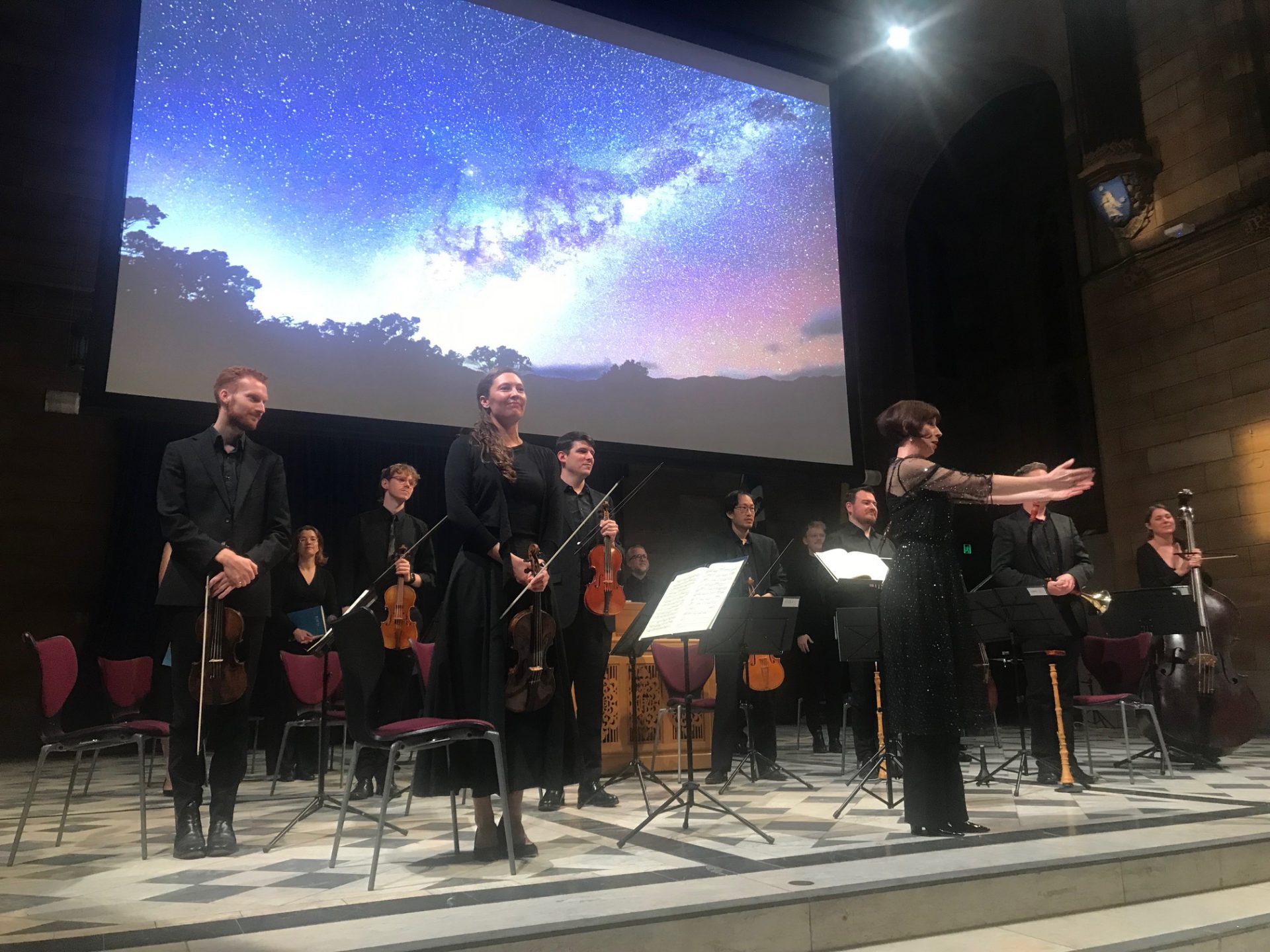It is not often that the general audience gets to attend a concert in the University of Sydney’s majestic Great Hall.
This concert was centred upon the theme of stars. In this light, the venue was made even more fitting, for the University’s motto is ‘sidere mens eadem mutato’ – ‘the stars change, the mind remains the same’. That emphasis on change and continuity is evident in the concert’s program, which explored the differences, and fundamental similarities, between European and Indigenous Australian perspectives on the cosmos.
First was the Sinfonia to Bach’s cantata Himmelskönig, sei willkommen. It is a smart way to start the concert, as it is in the style of a French overture. Just as the stately tempo of the French overture was meant to herald the arrival of the monarch, so Bach selected that style for his depiction of Jesus’ entry into Jerusalem (hence, “King of Heaven, Welcome!”). Madeleine Easton’s playing was skilful and her phrasing was punctuated, to bring out the sense of wonderment and anticipation that Bach tried to evoke. Mikaela Oberg on Baroque recorder matched Easton’s style, and her playing was sweetened with the mildest of vibratos.
This set the scene nicely for Tomas Luis de Victoria’s O Magnum Mysterium. It is a short but haunting piece that packs a punch. It has all the hallmarks of the typical Renaissance religious choral piece for small forces – dense counterpoint, with the theme introduced this time by sopranos Susannah Lawergren and Brianna Louwen, and followed with tight stretto by altos Hannah Fraser and Michael Burden, and the lower voices in succession. The acoustics in the Great Hall gave a great effect, but at time it seems there could be more dramatic variety in some passages, particularly as all voices suddenly come together in something like unison (a dramatic rhetorical tactic used by Renaissance composers to hammer home a particular passage as though in a declamatory style). There is a jarring dissonant clash halfway, and this was brought out nicely particularly by altos and tenors.
An interesting lecture by Professor Jonathan Bland-Hawthorn, a lecturer at the University’s Faculty of Science, soon followed. It was a potted history of ‘Western astronomy’, from Aristarchus and Hypatia to Galileo and Einstein. Of particularly interest was Johannes Kepler’s astronomical views and how they were related to Kepler’s musical interests as a composer. That Renaissance adoration of the Classical ideal – harmonia mundi – was evident throughout.
It was only fitting to then have a performance of lute works by Galileo’s father, Vincenzo Galilei. These excerpts from the so-called Well-Tempered Lute were performed deftly by Tommie Anderson, who emerged on stage with a small lute with fewer courses than what is often seen with lutes that play the basso continuo role in such concerts. Four pieces were played, each evidently based on the rhythms of regional tunes or dances; hence ‘Romanesca’ and ‘Moravia’. It was a unique opportunity to hear the lute speak of its own accord, but it seems the venue was too large for such a quiet instrument that was meant for intimate domestic enjoyment.
Uncle Jimmie Smith then gave a presentation on Indigenous perspectives on cosmology. What was emphasised was that the cosmos does not exist in the abstract; it is inexplicably tied to lived experience here on earth. This is consistent with Easton’s mission to unite her passion for Bach’s music, with ‘the tradition of the land we stand on’.
The world premiere of Troy Russell’s Clans seemed to encapsulate all this in music. Faint resemblance with Bach could be felt, but on the whole the rhythmic variety and experimentalism of the moderns was more prominent.
The night concluded with Bach’s ‘Wie schon leuchtet der Morgenstern’ (How beautifully the morning star shines). Those familiar with Buxtehude’s setting of the same hymn would notice that the same hymn tune is discernible, although augmented and not as fast as Buxtehude’s setting. The hymn tune was performed as cantus firmus by the sopranos, and this they did to great dramatic effect, subtly increasing and decreasing their emphasis throughout the first movement. It did, however, seem at times that the principal violins were playing too fast for Simon Wolnizer and Michael Dixon on corni to keep up.
Of particular interest was the distinctive curved shape of the oboe da caccia, performed spectacularly by Adam Masters who is truly a master of his instrument. Highlights included the ‘Erfullet’ aria, by Susannah Lawergren. There were minor slips in timing and breathing, but this aria is no mean feat and Lawrgren’s voice was by all accounts stunning. Jack Stephens’ voice was made for the sort of Bach bass recitatives which ‘Ein irdscher Glanz’ represents. The dramatic rendering he gave of the ‘reissen’ from ‘Aus unsrn Herzen reissen’ was deliberate, meaningful and moving, and is redolent of the dramatic rendering Bach himself gave of the words ‘Himmel reisse’ with that evocative passage which literally ‘rips’ through the cello in his earlier St Matthew’s Passion.
